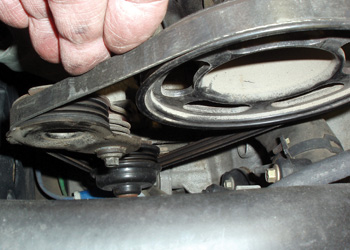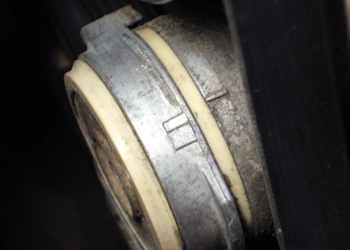If you’re like me, your mind tends to become stuck in past technology. Having started my career in the days when most engines had only one accessory drive belt, it’s easy to remember when I loosened an adjustment bolt on a generator, removed the old belt, and then used a large screwdriver to tension the new belt before re-tightening the adjustment bolt. If my memory serves me correctly, I remember changing many early Chevrolet six-cylinder fan belts for the grand sum of a buck-fifty, parts and labor included, for that 10-minute service.
 But technology moves on and by the mid-1970s, engines were equipped with multiple drive belts running on separate planes or pulleys that could require an hour or more to replace. In many cases, V-belts failed due to glazing caused by poor adjustment. Age, heat and load also caused the belts to crack and ultimately disintegrate. Driving torque is transmitted by the friction that’s created between the sides of the V-belt and the pulley groove. Wear in the belt and pulley will allow the belt to “bottom” in the pulley groove and thus lose the ability to transmit torque. In addition, it’s important to remind your collectible vehicle owners that routine belt tension adjustments are required maintenance on older vehicles.
But technology moves on and by the mid-1970s, engines were equipped with multiple drive belts running on separate planes or pulleys that could require an hour or more to replace. In many cases, V-belts failed due to glazing caused by poor adjustment. Age, heat and load also caused the belts to crack and ultimately disintegrate. Driving torque is transmitted by the friction that’s created between the sides of the V-belt and the pulley groove. Wear in the belt and pulley will allow the belt to “bottom” in the pulley groove and thus lose the ability to transmit torque. In addition, it’s important to remind your collectible vehicle owners that routine belt tension adjustments are required maintenance on older vehicles.
The neoprene rubber serpentine belt was popularly introduced during the 1980s because it is compact, operates on a single plane and is capable of transmitting driving torque to a half-dozen accessories. Since serpentine belts are extremely sensitive to belt tension, automatic tensioners were introduced to make serpentine belts nearly maintenance-free. Most serpentines of that era would last about 60,000 miles before belt wear, cracking and glazing began to limit torque transmission. The only drawback to serpentine technology is that each application requires an exact length and width, which adds many different stocking numbers to a drive belt inventory.
EPDM TECHNOLOGY
After 2001, Ethylene Propylene Diene Monomer (EPDM) rubber was introduced to help increase the service life of a serpentine belt and to reduce noise and cracking. Although EPDM belts don’t crack or glaze like neoprene rubber compounds, they do wear out and therefore require more than a visual inspection to determine the need for replacement.
If you look closely at a serpentine belt, you’ll see that a six-rib belt looks like a half-dozen very small v-belts molded together. Like the v-belt, the sides of the driving ribs tend to wear out and lose contact with the mating surfaces on the pulley. One manufacturer estimates that as little as a five-percent loss in belt rib material can significantly reduce the performance of the alternator, water pump, power steering and air conditioner drives. Keep in mind that belt slippage also tends to create or magnify vibrations created in driven accessories like the alternator and air conditioner compressor.
Since visual inspections can’t measure belt wear, it’s necessary to use a small, inexpensive tool to measure the depth of the v-grooves in the belt. Most belt manufacturers supply these tools free of charge or at a minimal cost. In most cases, EPDM belts should be checked for wear as the engine passes the 50,000-mile mark. At 100,000 miles, the belt usually passes into the extreme wear zone and should be replaced if it fails a visual inspection for cracking and glazing or fails the wear gauge test.
AUTOMATIC TENSIONERS
Needless to say, any serpentine belt must be correctly tensioned to reduce accessory drive vibrations, achieve maximum performance and increase service life. Since there’s very little “stretch” in a serpentine belt and since a serpentine belt is very sensitive to rib wear, it’s only logical that auto manufacturers decided to use an automatic tensioner to compensate for belt wear.
Automatic tensioners generally maintain belt tension by using a spring to press a flat idler pulley against the belt. In some applications, automatic tensioners are equipped with wear indexes that indicate belt wear and remaining service life. Automatic tensioners fail because the pivot bushings on belt tensioners wear out, which causes a rattling noise with the engine running. The internal tension spring can weaken, which allows the belt to slip. The internal dampener can also fail, which allows the tensioner pulley to bounce and potentially damage accessory bearings. A failed dampener can also cause plastic tensioner pulleys to develop flat spots, which aggravate noise and vibration complaints. The tensioner pulley bearing can also wear out, which causes a speed-sensitive whining or growling noise to emanate from the tensioner assembly.
To test an automatic belt tensioner, place a load on the belt by turning on the air conditioner. If the tensioner vibrates as the A/C compressor engages, the tensioner should be replaced. In addition, always be alert for belt squeal as the compressor is engaged. In some cases, belt squeal occurs when engine coolant contacts the belt or when the belt and/or the tensioner are worn out.
In many cases, belt manufacturers supply replacement belt, tensioner, and idler pulley kits to remedy belt performance complaints in high-mileage vehicles. Because some vehicles require a considerable amount of disassembly before the accessory drive and timing belts can be accessed, a master kit might include new timing belts, new serpentine drive belts, idler pulleys, crankshaft and camshaft oil seals and a new belt tensioner in the service package. Repair kits might also include a new alternator de-coupler pulley, which is used to decouple the alternator during deceleration. Other kits might be available that are designed to remedy vehicle-specific accessory drive complaints.
 STRETCH-FIT BELTS
STRETCH-FIT BELTS
Stretch-fit belts are the latest development in serpentine belt technology. As the name implies, stretch-fit belts eliminate the need for an automatic belt tensioner by actually stretching over the drive and accessory pulleys and requiring no further adjustment. Some vehicles like Ford and Subaru require special installation tools. Some belt manufacturers indicate that some aftermarket stretch belt installation tools might break the cords built into the belt. This invisible damage will cause the belt to perform incorrectly or fail at a later date. Most belt manufacturers supply the correct tools for correctly installing stretch belts.
BELT PERFORMANCE DIAGNOSTICS
Excessive belt wear and squeal can be difficult for even the best qualified technician to correctly diagnose. Excessive belt wear and belt squeal can be caused by a faulty tensioner or by pulley misalignment. If tensioner wear is suspected, the tensioner should be replaced. Pulley misalignment is normally indicated if the belt frays at the edge or if the belt squeals under load.
Because of their “flat” design, a one-degree misalignment can cause a serpentine belt to not fully engage the driving and driven pulleys. Most cases of pulley misalignment occur after an accessory like an alternator or, more commonly, a power steering pump is replaced. In many cases, the old steering pump pulley must be removed and re-installed on the new pump, which creates a potential for pulley misalignment. The pulley can easily be misaligned because most steering pump pulleys are press-fit designs. Some belt manufacturers provide laser-beam alignment tools that can be used to identify pulleys that don’t share a common operating plane with companion pulleys.
Whenever a belt is removed for service, always check the accessory pulley bearings for smooth, quiet operation. Noisy bearings indicate that the bearing or pulley should be replaced. In addition, check plastic pulleys for flat-spotting and check the ribbed pulleys for excessive wear. Keep in mind that operating in dusty environments drastically accelerates belt and pulley wear. If the vehicle is operating in a wet environment, be aware that worn belts and pulleys can slip because of “hydroplaning” because pulley wear decreases the air gap at the bottom of the pulley’s v-groove, which allows water to be trapped between the belt and pulley. The resulting hydroplaning causes the belt to slip, which reduces accessory performance, especially on high-load accessories like the air conditioner, alternator and power steering pump.
Gary Goms is a former educator and shop owner who remains active in the aftermarket service industry. Gary is an ASE-certified Master Automobile Technician (CMAT) and has earned the L1 advanced engine performance certification. He is also a graduate of Colorado State University and belongs to the Automotive Service Association (ASA) and the Society of Automotive Engineers (SAE).







